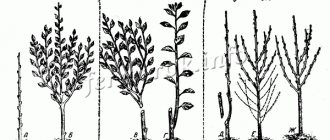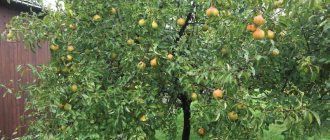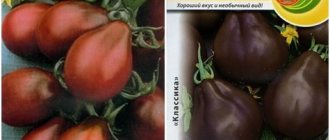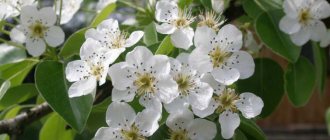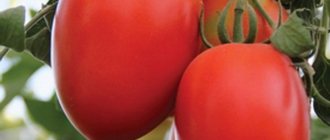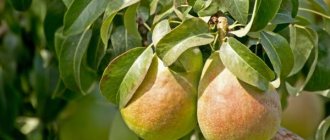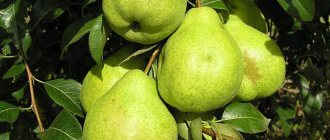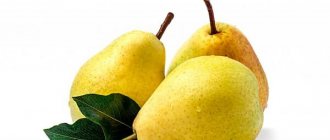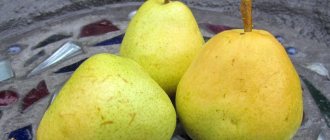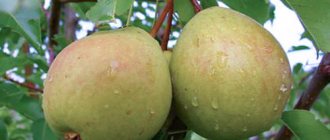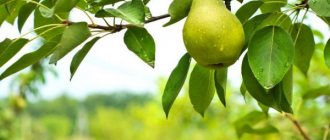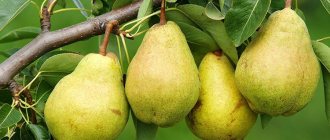Every year more and more varieties and hybrids of vegetable and garden crops and fruit trees appear. And the more surprising is the fact that some of their types remain popular for tens and hundreds of years. One of these “long-lived” crops is the Williams pear, the first mention of which dates back to the mid-eighteenth century. Over the years, this variety of pear tree is popular and loved among gardeners; moreover, the Williams pear has spread throughout the world, its seedlings have reached almost all continents.
Description of the Williams pear variety, detailed characteristics of several of its varieties, photos of fruits and trees, as well as reviews from gardeners and recommendations for growing in Russia: all information about this crop is collected in this article.
Description and characteristics of the variety
This variety of pears got its name thanks to an English breeder. The creator was focused on the warm climate of his region and did not particularly care about adapting the culture to the frosty winters of Russia. Therefore, the variety is recommended to be grown in mild climatic conditions.
The Williams pear variety is famous for its ease of care, sweet aromatic fruits and versatility in processing.
The tree is not tall, rarely growing up to 3 meters in height. It has classic ovate-shaped foliage, slightly curved with shine on the outside. The crown is dense, pyramidal. The shoots are powerful, thick, and arched. The crop is not self-fertile, so there is a need to plant a pollinator variety nearby. It begins to bear fruit after the third year of life. The fruits are juicy and aromatic.
For reference! In the State Register of the Russian Federation, the Williams pear is registered as an early autumn one. Its other name is Duchess summer.
The variety is recommended for growing in warm climates
Description of the tree
The tree grows quickly and rapidly. It produces fruits from 3-4 years old, if there is quince as a rootstock. After the first fruiting, Williams growth slows down. The spreading, thickened crown grows at an angle. The branches are brownish in color with a gray tint, bending to the ground under the weight of the fruit. The pear is not capable of self-pollination. The leaves are large, oval, smooth and shiny. There are small, frequent serrations along the edge of the leaf. Blooms late.
Fruit
The fruits are usually pear-shaped and large. The weight of each fruit ranges from 170 to 250 grams. The skin is thin with dark specks. The color of the fruit is yellow with ruddy sides. Some subspecies may be red.
The pulp is juicy with a creamy tint. Delicate in structure, with a slight graininess. The fruit tastes sweet, honey with nutmeg notes. The aroma is bright, rich.
Fruit color is yellow with ruddy sides
Productivity and storage of fruits
Each inflorescence of the variety has at least 5 flowers, of which 2-3 pears are tied. The harvest ripens in early August. The yield characteristics of this crop were highly appreciated. The older the tree, the more fruit. But we should not forget about the influence of external factors: place of growth, climate and agricultural technology.
A tree older than 10 years, with good care in mild climatic conditions, can please the gardener with a 150-kilogram harvest.
At room temperature, the fruit will last a maximum of a week. In the basement or refrigerator no more than a month and a half. Longer storage requires following some recommendations:
- early harvest, a week before full ripening;
- wrapping each fruit with parchment;
- neat storage in a wooden box;
- the storage temperature should not be lower than 1 degree below zero and not higher than 2 degrees above zero;
- air humidity within 90%;
- 2 times a month check for spoilage of fruits;
Important! Storing fresh pears is not long-term. It is more advisable to store the fruit after processing: in the form of marshmallows, preserves, jams, dried fruits and compotes. When freezing fresh product, storage can be extended for up to two years.
The yield characteristics of the Williams pear variety are highly rated
Cyclicity of fruiting and self-fertility
The William pear blooms early but lasts a long time. Full ripeness of the fruit occurs in the second ten days of August. The volume of the harvest depends on climate conditions and tree care measures.
Since the variety is not self-fertile, there must be a pollinator tree nearby. More often it is Forest Beauty, Pass Krassan, Aleksandrovka or Oliver de Ser.
Harvesting and storage
The first pears ripen after August 10th. As they mature, they can be removed from the tree. But the fruits are resistant to falling, so if you can’t harvest on time, you don’t have to worry; for several days or even weeks, the pears will be able to stay on the branches and not fall. In the refrigerator, the harvest can be stored for up to 1.5 months.
Williams pear is suitable not only for fresh consumption, but also for processing. It produces delicate jam, sweet preserves, and compotes with a rich aroma and taste. This variety is also suitable for drying.
Williams pear produces delicate jam, sweet preserves, compotes with a rich aroma and taste
Interesting!
You can freeze Williams pears, but once thawed they may have a watery, bland taste. It is because of this that it is most often simply dried. Dried slices not only contain many vitamins, but also have a sweet taste. They can be used for compotes and eaten just like that.
Diseases and pests
Marbled pear: description of the variety, pollinators
Williams is a variety susceptible to diseases characteristic of pear trees. More often like:
- scab;
- fruit rot;
- root cancer;
- cytosporosis;
- rust.
For this variety, attacks by insect pests are not excluded.
For preventive and sanitary purposes against rust and scab, trees should be treated with Bordeaux mixture or colloidal sulfur dissolved in water twice a year.
To combat cytosporosis, garden pitch and copper sulfate are used.
To prevent fruit rot, use iodine solution or other fungicides purchased at gardening stores.
If root cancer is suspected, the plant is destroyed at the first signs of disease. Otherwise, you can destroy nearby trees. To avoid disease, before planting in the ground, seedlings are kept in a solution of copper sulfate for 20 minutes.
Sanitary spraying of trees occurs 2 times a year. To do this, use fungicides Corsair, Iskra, Aktara or Inta-Vir.
Varieties of Williams pear
Pear Simply Maria: description of the variety, pollinators for it
The description of the Williams pear variety implies the presence of several subspecies that are not inferior to it in taste:
- Curé. The subspecies loves warm places, blooms profusely and bears fruit well. Flowering with a pinkish tint. Pears are elongated, bright yellow in color. The pulp is juicy, grainy, sweet and sour in taste.
- Williams summer. The best representative of the subspecies of its variety. It is growing rapidly. Reaches maximum maturity at 12 years of age. The culture is low with a yellowish trunk and branches. It blooms late and bears fruit. The first pears can be picked no earlier than the beginning of September. Fruits with shiny, greenish skin, pink-sided. The taste characteristics of the yellowish-white juicy pulp received the highest rating.
- Williams Red or Rouge Delbara is a compact tree, densely covered with foliage. You should expect a harvest from it no earlier than the fifth year from planting. Ripens by the end of August. The fruits are oblong, with a lumpy burgundy skin. The pulp is creamy, sour, with a bright nutmeg flavor.
- Moscow Duchess. It has high frost resistance and average yield. The fruits are early and very large. Sometimes up to 1 kg in weight. It has a delicate soft taste and pleasant aroma.
- Winter Duchess. Easy to care for, but picky about the soil. Loves sunny areas. Gives a good harvest of large fruits. But it’s late, in the middle of autumn. The fruits are large, weighing 500 g, yellow in color. The taste is honey with a slight sourness.
Bears fruit from 3 years
| Pear Williams | |
| general characteristics | Vigorous tree up to , bisexual |
| Ripening period | Second ten days of September |
| Taste | Sweet, with a delicate floral aroma |
| Fruit | 130-210 g |
| Fruiting | 40–60 kg per tree |
| Winter hardiness | High |
| Pests and diseases | High resistance to diseases and pests |
Williams pear has a very high yield
The name of the variety is Williams pear. The variety was bred by the English breeder Wheeler in 1796 in Southern England (Berkshire County). Richard Williams became an active distributor of the variety, and he gave the pear his name. The progenitor varieties of Williams are not known. This variety was brought to Crimea in 1860 and today is in third place in popularity.
Shape: medium-sized or low-growing fruit trees with a wide-pyramidal or round-pyramidal, often asymmetrical, densely leafy crown. The bark on the trunk and skeletal branches is smooth and gray in color. The shoots are straight or slightly arched, light, with a yellowish tint.
The leaves are large, smooth, glossy, ovoid, slightly curved from the edges to the center (boat-shaped). The tips are short-pointed, the edges are finely crenate. A characteristic feature of the variety are raised light-colored lateral veins.
The flowers are medium-sized, matte white, collected in inflorescences of 6-7 pieces, open before the leaves bloom, resistant to adverse weather conditions. Flowering later, long lasting.
The fruits are medium and large in size, oblong-pear-shaped, slightly lumpy, firmly held on the branches. The largest fruits are produced by young trees (180 - 200 g). On mature trees, their weight is usually 150 - 170 g. The skin is very fragrant, thin, glossy, light green during the harvesting period. Ripe pears become waxy yellow with small gray dots. The sun barrel is painted in a delicate pink-red color. The pulp is yellowish-white, very tender, buttery, melting, juicy, sweet with a slight pleasant sourness and a delicate aroma with notes of nutmeg. Taste qualities are assessed on a 5-point tasting scale at 4.8 points. Pears produce high-quality processed products: drying and canning.
Fruiting occurs in 3–4 years if the variety is grafted on a quince, and in 5–6 years if it is grafted on a pear.
Productivity is very high. Young (10-year-old) trees produce about 35 kg of fruit, and older (18-20 years old) trees produce up to 150 kg or more.
Harvesting - the second ten days of August (period of removable maturity). Pears can be stored in the refrigerator for 1.5 months.
The Williams variety is a self-sterile variety. To produce an ovary, pollinators are needed. The best of them are the varieties Aleksandrovka, Lesnaya Krasavitsa, Bere Ardanpont, Lyubimitsa Klappa, Pass Krassan, Olivier de Serre.
Soil requirements. The variety is not demanding, but prefers rich fertile soils, well moistened
This is especially important for low-growing trees. Attitude to light
It is necessary to plant in well-lit places
Attitude to light. It is necessary to plant in well-lit places.
Frost resistance is low.
The Williams pear variety is characterized by low resistance to drought, both to dry soil and dry air.
This is especially true for young trees
Therefore, it is important to plant pear trees in areas protected from the wind.
Disease resistance. The Williams pear has poor resistance to some diseases.
Advantages and disadvantages
The Williams pear, like other crops, has a number of advantages and disadvantages. The advantages of this type include:
- precociousness;
- high yield, especially in mature trees;
- beautiful appearance of the fruit;
- not demanding on soil indicators;
Along with the advantages, there are also some disadvantages of the variety:
- low winter hardiness, risk of freezing of tree shoots and roots;
- lack of self-pollination;
- drought intolerance;
- susceptibility to disease;
The variety has many advantages such as: high yield, good taste of fruits and their rich beneficial properties.
Landing
To plant a seedling, choose a well-lit place protected from drafts. Pollinator trees should grow not far from the planting material. Otherwise, there will be no harvest, because Williams is not a self-fertile crop. The seedling is chosen to be no younger than one year old and no lower than 1.5 meters in height.
Trees are planted in the spring, after frosts, but before the buds swell. Autumn planting is carried out before the first frost, so that the seedling has time to receive all the necessary nutrients from the soil.
Landing technology
The planting hole must be at least 80 cm in diameter and depth. The pear root system is kept in a growth stimulator for about 10 hours, after which it is lowered into a hole and sprinkled with a mixture of garden soil, humus and superphosphate. Then water generously. To support the seedling, a peg is dug in nearby. The distance between trees is maintained at least 4 meters.
The hole for planting a seedling must be at least 80 cm in diameter and depth
Characteristics of wood
Representatives of the Williams variety belong to the category of vigorous trees. The wide spreading crown does not have a clearly defined shape, but most often it is classified as pyramidal. Elongated thick shoots often have an arched shape.
Pollinator varieties
For each subspecies, varieties suitable for pollination have been identified:
- The winter variety brings a good harvest when adjacent to Olivier de Cerre and Duchess.
- summer Duchess near the trees Lesnaya Krasavitsa, Aleksandrovka, Pass Krassan.
- Red Williams is well pollinated by Bere Giffard or Hardy pears, Clapp's favorite.
Tree height
Representatives of the species are classified as low compared to other varieties. Mature trees rarely grow above 3 meters in height.
Lifespan
Domesticated plants have a shorter lifespan compared to wild ones. When yields decrease, mature trees are rejuvenated, thereby prolonging the fruiting period.
Winter hardiness
Pear trees do not tolerate frosts well, much less severe frosts, so they are mainly grown in areas with warm climates. When planting a plant on waterlogged soil, especially in low areas, young seedlings may freeze.
Agricultural technology
For active growth and fruiting, it is necessary to properly care for the crop. Namely:
- Watering should be regular, especially during the dry season. In the first 3 years, the pear is watered abundantly every month. The area around the trunk should not dry out. In case of excessive precipitation, watering is briefly reduced. They completely stop irrigating the tree before frost.
- Regular weed control.
- Mulching will help retain moisture in the tree trunk circle.
- Fertilizers are applied three times a year. In the spring, Williams is fed with nitrogen substances, in the summer with mullein, and in the fall with potassium-containing preparations.
- Pruning is carried out in spring and autumn. To prevent branching, branches are shortened by 40 cm every year. In addition, weakened or diseased shoots are removed for sanitary pruning.
Beneficial features
In addition to their pleasant taste and low calorie content, Williams pears have other beneficial qualities:
- Eating pear fruits can significantly increase your immunity.
- Pear pulp has a beneficial effect on the functioning of the gastrointestinal tract, liver and kidneys.
- Due to the high content of vitamin C in fruits, the walls of blood vessels are strengthened, becoming elastic and strong.
For reference! With the help of decoctions and infusions from the fruits of the Williams culture, bronchitis, tuberculosis, and tachycardia are treated. Pears are also good as antidepressants.
William pears have many beneficial properties and are even good as antidepressants.
Reviews
Marina
Nalchik
My parents have had this pear growing at their dacha for about 30 years. The tree is small, but there are always a lot of fruits on it. The pears are large and very juicy. Mom makes jam from them that you just can’t stop eating.
Vladislav
Belozersk
The pear tree often gets sick and after rain almost always appears scabbed on it, so it is necessary to spray it frequently with antifungal agents. The good news is that the trees are low-growing and it is not difficult to process them.
Aleftina
Nikolaev
I love summer Williams, it's so tasty and sweet. Although the pears don’t last long, we manage to make jam and even make dried fruit. I’m quite happy with the tree, sometimes leaf rollers and flower beetles live on it, I need to protect it from them.
Possible problems in growing
When growing a pear tree, you may encounter some problems:
- Susceptibility to diseases and pest attacks. Do not neglect prevention from diseases and insects.
- Low winter hardiness. Before the onset of cold weather, it is recommended to wrap young seedlings.
Those gardeners who have not yet planted a Wilms pear on their plot have a good opportunity to acquire one. The variety has earned fame and recognition from summer residents all over the world for its unpretentiousness, high yield, taste and beneficial properties. With proper care and following simple basics of agricultural technology, the crop will delight you with a rich, aromatic harvest every year.
Description of the fruit
Williams fruits have a standard pear shape. Depending on the subspecies, the fruit may be lumpy and uneven. The color of the peel in a mature state varies according to the subspecies from golden to deep burgundy. A red-brown tan may appear on one side of the fruit. Due to their large size and high yields, pears can break off branches under their weight.
Calorie content
Due to their high dietary fiber content and low energy value, pears are ideal for a variety of diets. They create a feeling of fullness in the stomach and help eliminate excess fat, cholesterol and toxic substances from the body. Calories - 47.6 kcal Proteins - 0.6 g Fats - 0.3 g Carbohydrates - 11.3 g Water - 87.5 g. Chemical composition: sugar content 8.3%, dry matter 13.8%, acids - 0.42%, P-active catechins 42.6 mg/100 g, ascorbic acid 5.4 mg/100 g.
Find out about the calorie content of pears from this article.
The fruits have excellent taste. The white juicy pulp, with a yellowish tint, has a delicate wine-sweet taste. Dessert characteristics are complemented by the sourness of the pulp and nutmeg aroma.
Fruit size
All subspecies of the variety produce large fruits, the size of which is not lower than average. The smallest pears weigh 150-170 g. Larger and more voluminous fruits are produced by young trees - 200-250 g. The shape of pears is oblong, with a typical, slightly bumpy surface.
Usage
The external and taste characteristics of pears on a five-point tasting scale are rated at 4.8 points.
The fruits of all subspecies are considered dessert and can be eaten fresh. Thanks to the rich aroma and delicate taste of the pulp, they are suitable for making jam, jam, and juices.
